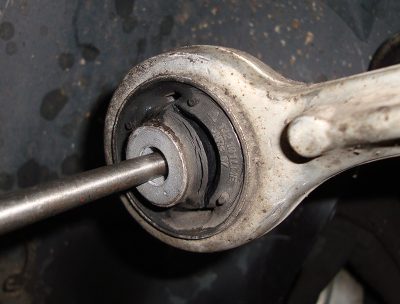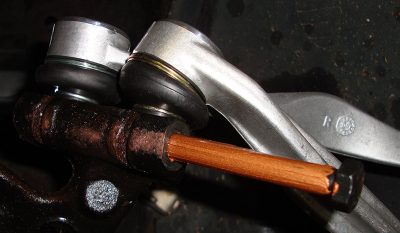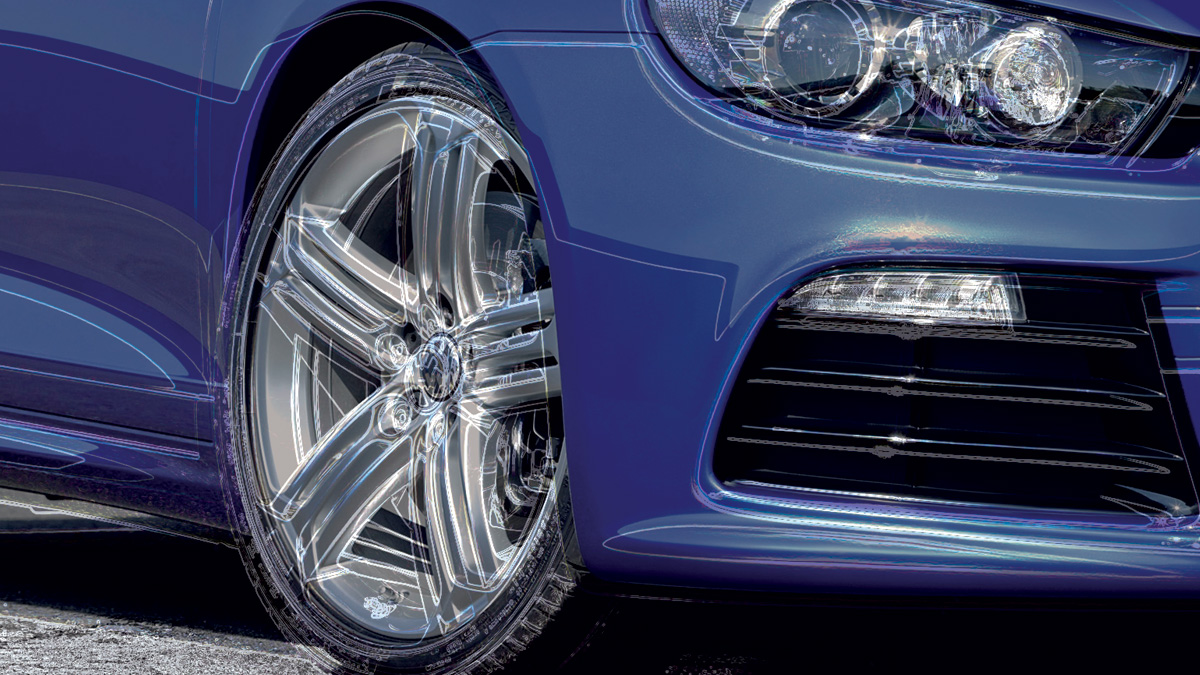The feeling of control is the single most important factor of the driving experience. It gives the driver confidence in the vehicle’s capabilities. Let’s help maintain that new car “feel†— and a happy customer.
Most car owners feel a personal connection with their vehicles. They become familiar with little idiosyncrasies. When the “feel†of the vehicle changes suddenly, they are the first to notice the difference. In other cases, a problem develops more gradually, and the driver becomes accustomed to it without noticing anything different. In the first case, you may have a tough time isolating the cause of the problem since it may be some minor deflection. In the second case, you may find a multitude of problems and have trouble selling the work since the customer believes the vehicle is fine. Either way with these challenges, you need to be able to diagnose various symptoms, commonly referred to as noise, vibration and harshness (NVH).
In the case of a chassis noise, vehicle dynamics come into play. You certainly need to drive the vehicle and duplicate the conditions the customer experiences. Very often the diagnosis is driven by the first step in process, which is the interview with the customer. Sure, you’d like to simply tell them, “We’ll handle it,†but good customer interviews not only show your concern, they also get them involved in the process and make them feel you are the right person to do the job.    The next step is duplicating the conditions under which the problem occurs and listening and feeling for its effects.
In order to diagnose a handling problem, you should know what type of steering and suspension system you’re dealing with. Different manufacturers use different designs, which have different characteristics. Each manufacturer chooses a design that best fits its philosophy. In the case of Volkswagen, the “fun-to-drive†quotient has a high priority, and a MacPherson strut front suspension and a trailing-arm cross-member rear suspension, as used on the Golf and Jetta, fills the bill. Since ’98, the Passat and later Phaeton models use a multilink front suspension that provides the necessary steering and suspension articulation to offer even more sophisticated handling characteristics.

The MacPherson strut and trailing arm combination is a solid, trouble-fee design that requires minimal maintenance. Simplicity is the key to its durability, with only a lower ball joint, two lower control arm bushings, tie-rod ends and upper strut tower mounts to wear.
Multiple links offer the engineers tremendous control of wheel alignment as the suspension moves through its range of travel. While the handling is exceptional, the complexity does make the diagnostic process more of a challenge. If a single lower ball joint were to wear out, just replacing it would alleviate the problem. But with two ball joints on multiple links, the task becomes a little more difficult. Considering that your customers are not enjoying a bull market these days, they’ll be more inclined to have you identify and only repair the immediate problem, as opposed to replacing all the components in the front or rear suspension at once.   
Some diagnostic testing is the same for both designs, such as for wheel bearings. Being front- or four-wheel drive vehicles, the front driveshafts run through sealed unitized bearings. You can check deflection by rocking the wheel at the 12 and 6 o’clock and the 9 and 3 o’clock positions, but more often than not the driver will notice the howl of a bearing in left- or right-hand turns long before you feel looseness on a lift.
The Players Are On The Field
Knowing the components of the front suspension is just as important to the diagnostic process as interviewing the customer. The MacPherson strut design used on the Golf and Jetta has been around for decades. It’s simple and inexpensive, using a lower control arm that attaches to a spindle.    The upper portion of the spindle is connected to the strut assembly, which functions as both the upper control arm and the spring/shock absorber. A steering rack controls outer tie-rod ends that attach to the spindle.    Finally, links connect the lower arm to the anti-sway bar.
The rear suspension is a solid crossmember with trailing arms that house the rear wheel bearings. This is another durable design that rarely needs anything more than the occasional wheel bearing and shock absorber/spring assembly replacement.    Shock absorbers help maintain tire contact with the road over bumpy surfaces, yet they are often overlooked as a means of improving ride and handling. The use of O.E. shocks and struts will give like-new performance throughout the vehicle’s life.

With Volkswagen’s multi-link suspension systems, there are new players on the field. For example, there are independent ball joints attached to the upper and lower portion of the spindle. These joints allow the rotational axis of the spindle to change positions, creating what is known as “Virtual Center Steering.†This engineering advance enhances low-speed maneuvering through increased articulation of the steering axis, yet still provides steering feedback at highway speeds. It also optimizes the working angle of the constant velocity joints on four-wheel drive systems, and helps reduce bump steer.   

Four links attach the spindle to the chassis. The upper two, one forward and one rear, control the travel of the upper portion of the spindle. Two lower arms, again one forward and one rear, control the travel of the lower half of the spindle. Each link has one ball joint at the outer end for mounting in the spindle, and bushings at the inner end to mount to the chassis.    The rear suspension has the crossmember-with-trailing-arm design found on the Golf/Jetta, unless it has 4WD. For them, an upper and lower “Aâ€-type control arm is used, but the pick-up points are bushings, not ball joints. This is another sturdy design that usually does not require much work.   

The Touareg is a relatively new model with the tried-and-true double “A†arm design. They don’t really look like “A†arms anymore, but there are upper and lower arms that attach to the spindle. The upper arm has a single ball joint at the spindle and two bushings to mount to the chassis. The lower arm is similar to the ones found on the Golf and Jetta with two inner bushings and one outer ball joint, which is serviceable and bolts both to the spindle and the lower arm. The upper arm is not serviceable and must be replaced when the ball joint is worn.
The Prognosis
As discussed earlier, your first step after interviewing the customer is to road test the vehicle and put it through its paces, with the customer riding along, if possible. To get the whole picture, you should drive the vehicle using every possible combination of maneuvers. This means accelerating while turning the wheel both left and right. Then, do the same while decelerating. In a safe road-test area, you may also want to try this in reverse.    You may feel something “give†in the suspension under hard acceleration, but usually what you’ll notice are motor mount and driveline issues. Hard braking may also display problems in the front suspension. The goal is to get a feel for the problem through different driving conditions. You may uncover problems that your customer never noticed due to his or her driving style.
If while driving straight, you feel the whole vehicle vibrating, this is probably due to a tire with broken cords, or a bent rim. If the problem is felt in the front end of the vehicle, you have to isolate its location. You should ask yourself these four questions: Do I feel the problem in the brake pedal? In the steering wheel? In the seat of my pants? Or, all of the above? If it’s in the brake pedal, you’ll want to check for rotors with thickness variation, but other components can also cause this feeling.    While braking, lighten up on the pedal and see if the pulsation disappears. If it does, then the rotors are probably not the trouble. If they were, you would still feel the vibration in the steering wheel as well as the brake pedal. If you feel the pulsation more in the steering wheel, and disappears under lighter braking, it’s possible that the rear bushings of the lower control arms are torn or worn, allowing the camber and caster to oscillate as they’re loaded.
These are just examples of how to approach a steering/suspension/handling problem. You may have your own methods that work for you. Here, we are just offering our own perspective.
Isolation And Testing
At some point, you are going to have to start examining the critical components involved.    This is done by stressing the system while looking for unwanted movement or looseness between ball joints and/or bushings. In the case of a ball and socket joint, such as the lower ball joint, it is a good idea is to squeeze it together with a large pair of pliers to see if there is any play, which may cause a noise as the ball joint is stressed while driving, and/or steering alignment angles may change while the vehicle is moving. In this case, examining tire wear patterns can also indicate if there is a front-end problem. An unusual amount of wear on the inner and outer portion of the tire indicates excessive negative and positive camber, respectively. If you notice a “scalloped†pattern, where the trailing edge of the tread has a sharp edge and the leading edge of the tread is worn down, incorrect toe-in or -out is implicated, depending on whether the problem is on the outer edge of the tire, or the inner edge.

With multi-link suspensions, testing ball joints is similar. You can try to collapse the ball joint with your big pliers, but in many cases you can just grab the link with your bare hand and try moving it around feeling for a worn ball socket.    These systems are made of aluminum links with steel ball socket inserts to provide both strength and light weight. These links tend to wear out faster than conventional control arms, and will probably need to be replaced on high-mileage vehicles.
Bushings are also capable of causing vibration and handling issues. With a visual inspection, you can usually see if the inner mounting point has totally separated from the outer mounting. In the case where the bushing is soft from wear or contamination, or torn, you may only notice the tears by stressing the component. Use a pry bar to exert pressure and examine the bushing. You’ll notice how easy it is to move a softened bushing, or you may see cracks in the rubber while it is being stretched into different directions. ÂWith soft or cracked bushings, the suspension links deflect more than they should, allowing the spindle to move around and change steering geometry, perhaps even creating vibrations.
When you have replaced the problem suspension part, you are still not finished with the job because the alignment may have changed. It is very important that you perform a wheel alignment on the axle you were working on. It is always a good idea to perform a four-wheel alignment to check for other problems. In the case of a multiple-link suspension system, a “raised-toe†alignment procedure needs to be followed. With a paid subscription to www.erwin.vw.com (edit: https://erwin.vw.com/erwin/login.do) you can look up proper adjustment procedures and wheel alignment specifications.
In Conclusion
Although Volkswagen has provided durable designs for its suspension systems over the years, there are still parts that wear out and provide a service opportunity. Using Volkswagen factory (O.E.) parts for repair ensures that the vehicle is returned to its original state, which will make your customers happy. Who couldn’t use that?





0 Comments